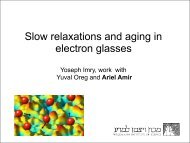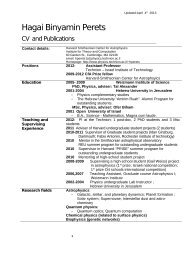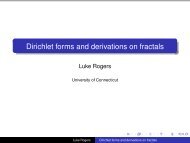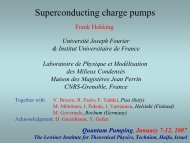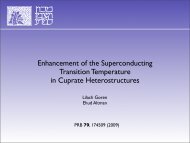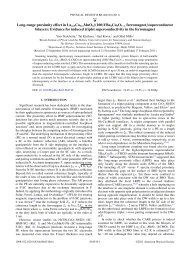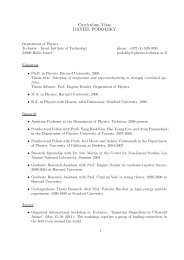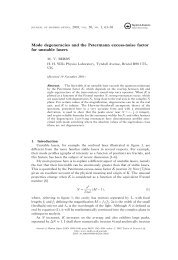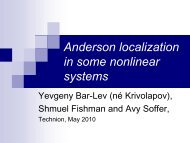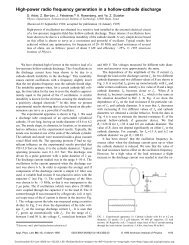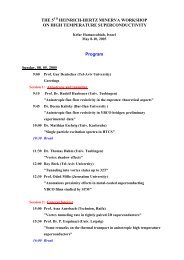Appl. Phys. Lett. 68 988 - Physics@Technion
Appl. Phys. Lett. 68 988 - Physics@Technion
Appl. Phys. Lett. 68 988 - Physics@Technion
You also want an ePaper? Increase the reach of your titles
YUMPU automatically turns print PDFs into web optimized ePapers that Google loves.
Near-field optical spectroscopy of single quantum wires<br />
T. D. Harris a)<br />
AT&T Bell Laboratories, 600 Mountain Ave. Murray Hill, New Jersey 07974<br />
D. Gershoni<br />
Department of <strong>Phys</strong>ics, Technion, Haifa 32000, Israel<br />
R. D. Grober<br />
Department of <strong>Appl</strong>ied <strong>Phys</strong>ics, Yale University, New Haven, Connecticut 06520-8284<br />
L. Pfeiffer, K. West, and N. Chand<br />
AT&T Bell Laboratories, Murray Hill, New Jersey 07974<br />
�Received 18 August 1995; accepted for publication 2 December 1995�<br />
Low temperature near-field scanning optical microscopy is used for spectroscopic studies of single,<br />
nanometer dimension, cleaved edge overgrown quantum wires. A direct experimental comparison<br />
between a two dimensional system and a single genuinely one dimensional quantum wire system,<br />
inaccessible to conventional far field optical spectroscopy, is enabled by the enhanced spatial<br />
resolution. We show that the photoluminescence of a single quantum wire is easily distinguished<br />
from that of the surrounding quantum well. Emission from localized centers is shown to dominate<br />
the photoluminescence from both wires and wells at low temperatures. A factor of 3 absorption<br />
enhancement for these wires compared to the wells is concluded from the photoluminescence<br />
excitation data. © 1996 American Institute of <strong>Phys</strong>ics. �S0003-6951�96�04406-1�<br />
Optoelectronics based on very thin layers of semiconductor<br />
heterostructures, such as quantum wells �QWs�, are<br />
now dominant for many commercial applications. In an attempt<br />
to gain further from the reduction of dimensionality, 1 a<br />
world wide research effort to bring 1D quantum structures<br />
such as quantum wires �QWRs� and 0D quantum structures<br />
such as quantum dots to the same degree of perfection<br />
achieved in the 2D quantum systems has been underway<br />
during the last decade.<br />
Among the most promising ways to achieve this goal for<br />
1D structures is cleaved edge overgrowth �CEO�. 2 This technique<br />
utilizes two orthogonal directions of epitaxial growth,<br />
exploiting the precision of layer thickness control to form<br />
uniform intersecting planes of semiconductor. Two different<br />
CEO quantum wire systems have been fabricated and studied:<br />
�a� Strained layer QWRs �SQWRs� in which confinement<br />
to 1D is produced by one dimensional pseudomorphic<br />
strain induced in the �110� oriented cleaved edge QW by a<br />
�100� oriented strained layer QW. 3 �b� T-shaped QWRs<br />
�TQWRs� in which quantum confinement to 1D is produced<br />
along the intersection line between the planes of a �100�<br />
oriented QW and that of a �110� oriented cleaved edge overgrown<br />
QW. 4<br />
Study of single CEO-QWRs requires care to ensure the<br />
unambiguous separation of wire and well spectroscopy. Far<br />
field optical spectroscopy has proved to be the most revealing<br />
tool for the characterization of 2D structures 5 but suffers<br />
a substantial obstacle for CEO QWRs. The probed volume of<br />
QW is orders of magnitude larger than the probed volume of<br />
a QWR. The QWR spectral features are likely obscured by<br />
or attributed to QW features. We show here that the enhanced<br />
spatial resolution of low temperature near-field scanning<br />
optical microscopy �LT-NSOM� surmounts this obstacle,<br />
permitting unambiguous single QWR studies. There is<br />
substantial existing spectroscopic data on multiple and arrays<br />
a� Electronic mail: tdh@clockwise.att.com<br />
of CEO QWRs. 3,4,6–8 The added clarity of probing a single<br />
wire structure is considerable, since heterogeneity and carrier<br />
and electromagnetic field interactions between neighboring<br />
wires are eliminated. We report here low temperature, near<br />
field imaging spectroscopy of the first CEO system, SQWRs.<br />
The low temperature NSOM microscope used for this<br />
study has been described in detail. 9 Different from this prior<br />
report, all the data reported here used excitation and collection<br />
with the same aluminum coated, tapered fiber probe at a<br />
sample temperature of 4 K. The excitation radiation was<br />
launched to the fiber from a computer controlled Ti:sapphire<br />
laser. An intensity stabilizer �‘‘noise eater’’� and quarter- and<br />
half-wave plates were inserted between two separate sections<br />
of the Corning 850 nm single mode fiber used for our NSOM<br />
probes. Fusion spliced into the second section of the fiber is<br />
a 3 dB two way splitter. It provides a convenient means of<br />
simultaneously monitoring the light sent to the probe, and<br />
detecting the light collected by the probe. In order to simultaneously<br />
excite and detect through the same tip, efficient<br />
discrimination between excitation and emitted light is required.<br />
Elastically scattered light is efficiently filtered by a<br />
triple spectrometer. The fiber used in this study had no significant<br />
fiber fluorescence for the relevant excitation wavelengths<br />
�700–800 nm�. We thus attribute the background<br />
light detected to either fluorescence from the aluminum silica<br />
interface or to Raman scattering within the fiber itself. This<br />
background light is typically 1–2 orders of magnitude larger<br />
than the photoluminescence �PL� signal collected by the tip<br />
�diameter � 200 nm�, highly structured, and strongly polarized<br />
parallel to the exciting radiation. By careful adjustment<br />
of retardation plates in both the excitation and detection<br />
channels, extinction ratios of sample luminescence to background<br />
of as much as 3 orders of magnitude could be<br />
achieved. The light emitted around the fiber tip was collected<br />
by a reflecting objective contained within the cryostat and<br />
directed to a second CCD camera equipped monochromator.<br />
The sample studied here was grown as follows. In the<br />
<strong>988</strong> <strong>Appl</strong>. <strong>Phys</strong>. <strong>Lett</strong>. <strong>68</strong> (7), 12 February 1996 0003-6951/96/<strong>68</strong>(7)/<strong>988</strong>/3/$10.00 © 1996 American Institute of <strong>Phys</strong>ics<br />
Downloaded¬31¬Dec¬2000¬¬to¬132.<strong>68</strong>.1.29.¬¬Redistribution¬subject¬to¬AIP¬copyright,¬see¬http://ojps.aip.org/aplo/aplcpyrts.html.
FIG. 1. �a� Single pixel PL spectra from an NSOM image. If the emission<br />
intensity is integrated over the shaded wavelength interval, the �b� four fixed<br />
wavelength emission images result. Images are numbered from the spectra<br />
indicating the wavelength interval.<br />
first growth step, molecular beam epitaxy �MBE� was used<br />
to grow five strained In 0.10Ga 0.90As QWs of 300, 150, 75, 38,<br />
and 18 Å respectively, on a �100� oriented GaAs substrate.<br />
The strained QWs, are separated by 1.0 mm thick layers of<br />
GaAs and capped by a 2 �m thick GaAs layer. It was<br />
cleaved during growth, exposing a �110� facet onto which the<br />
following layers were grown in succession: 200 Å<br />
Al 0.3Ga 0.7As, 80 Å GaAs, 200 Å Al 0.3Ga 0.7As, 35 Å GaAs,<br />
200 Å Al 0.3Ga 0.7As, and 50 Å GaAs. On the cleaved face are<br />
thus formed ten single SQWRs, one wire in each of two<br />
�110� QWs, for each of the five �100� strained InGaAs QWs.<br />
Low temperature cathodoluminescence �CL� was used previously<br />
to show that emission from the AlGaAs/GaAs �110�<br />
QWs is red shifted directly above the strained layers. 8,10<br />
Here, using NSOM spectroscopy we overcome two major<br />
disadvantages of CL: �a� The loss of spatial resolution due to<br />
the large diffusion length �� 1 �m� of the high excess energy<br />
cathodo-excited carriers. �b� The lack of excitation energy<br />
tunability.<br />
Two modes of data acquisition were used: PL spectral<br />
images are generated by fixing the excitation energy and recording<br />
a PL spectrum for 1–5 s at each tip position. A large<br />
four dimensional �x,y,�,I) data set is thus generated. Alternately,<br />
at a single tip position �image pixel �x, y�, emission<br />
intensity integrated over a selected spectral range is recorded<br />
as a function of the excitation energy.<br />
In Fig. 1�a� we show four PL spectra which were selected<br />
from the 441 near-field spectra generated in a 21�21<br />
pixel scan of a 2.5�2.5 �m square region of the CEO<br />
SQWR sample. The spectra are vertically displaced for clar-<br />
FIG. 2. �a� Single pixel PL spectra from the same area as Fig. 2�b� for<br />
wavelength near the 80 Å �110� QW. �b� Fixed wavelength images for the<br />
shaded intervals shown above.<br />
ity. In each spectrum a distinct spectral line is observed.<br />
These lines arise from carrier recombination within the �100�<br />
oriented strained InGaAs QWs. The spectrum marked ‘‘1’’<br />
results from recombination in the 18 Å strained QW and the<br />
lines marked ‘‘2,’’ ‘‘3,’’ and ‘‘4’’ result from recombination<br />
within the 38, 75 and 150 Å strained QWs, respectively. In<br />
Fig. 1�b� we show the four selective wavelength PL images<br />
associated with the spectral lines of Fig. 1�a�. The images are<br />
obtained by integrating the PL emission over the wavelength<br />
interval marked in gray on Fig. 1�a�. These images allow an<br />
accurate determination of the spatial source for each spectral<br />
feature. The position of the �100� oriented strained 18, 38, 75<br />
and 150 Å InGaAs QWs is clearly identified by these images.<br />
We have marked these positions by the bold dash lines<br />
on the images, for later reference.<br />
In Figs. 2�a� and 2�b� we show PL spectra and fixed<br />
wavelength images for recombination associated with the 80<br />
Å �110� oriented GaAs/AlGaAs QW for the same scan area<br />
as for Fig. 1. The four dashed bold lines of Fig. 2�b� mark the<br />
position of the strained �100� oriented InGaAs QWs as determined<br />
from Fig. 1�b�. The upper most spectrum in Fig.<br />
2�a�, marked ‘‘1,’’ is dominated by a spectral feature which<br />
peaks at 793 nm. This PL emission line is typical of the �110�<br />
oriented CEO 80 Å GaAs/AlGaAs QW as verified by far<br />
field spectroscopy in this work and previous studies. 3,7,8<br />
Spectrum ‘‘1’’ is from a pixel midway between the 38 Å and<br />
75 Å strained QW. The image clearly shows that the spatial<br />
origin of this emission strongly anticorrelates with the positions<br />
of the strained QWs. The lower three spectra in Fig.<br />
2�a�, marked ‘‘2,’’ ‘‘3,’’ and ‘‘4,’’ originate from pixels above<br />
3 of the strained QWs. The fixed wavelength images of these<br />
spectral lines strongly correlate with the spatial position of<br />
<strong>Appl</strong>. <strong>Phys</strong>. <strong>Lett</strong>., Vol. <strong>68</strong>, No. 7, 12 February 1996 Harris et al.<br />
Downloaded¬31¬Dec¬2000¬¬to¬132.<strong>68</strong>.1.29.¬¬Redistribution¬subject¬to¬AIP¬copyright,¬see¬http://ojps.aip.org/aplo/aplcpyrts.html.<br />
989
FIG. 3. Near-field PL �solid line� and PLE �dotted line� spectra of the 80 Å<br />
�110� QW �lower panel� and the 150 �80 ŠSQWR �upper panel�. A two<br />
Gaussians model fit used to determine the relative intensity is shown by the<br />
thin solid line.<br />
the �100� oriented strained InGaAs QWs, as can be seen in<br />
Fig. 2�b�. The three lower PL spectra in Fig. 2�a� are thus<br />
assigned to carrier recombination within the single SQWRs.<br />
The magnitude of these shifts is in agreement with previous<br />
measurements using far field optics and a large array of<br />
QWRs. 3,7,8 We note that both the PL images and the nearfield<br />
PL spectra �sharp spectral ‘‘spikes’’� clearly indicate<br />
that the emission from both the QWs and QWRs originate<br />
from fully �0D� localized centers. 11<br />
In Fig. 3 we show the PL �solid line� and PLE �dotted<br />
line� spectra of the 150 Å SQWR and the �110� oriented 80<br />
Å GaAs QW from a position between the strained �100�<br />
oriented InGaAs QWs. The all near-field PLE spectrum of<br />
the �110� CEO GaAs QW is indistinguishable from the far<br />
field PLE spectrum �not shown�. The excitonic transitions<br />
associated with the first heavy-hole excitons �HH1� and the<br />
first light-hole exciton �LH1� are marked in Fig. 3. The 5<br />
meV Stokes shift between the HH1 transition measured in<br />
PLE and that measured in PL is typical of �110� oriented<br />
QWs. 12 Since the NSOM tip, 3000 Å diameter is far larger<br />
than the SQWR, excitation of carriers in the QW can not be<br />
avoided. If there is efficient carrier diffusion, the spectral<br />
features associated with QW absorption are seen in the PLE<br />
spectrum of the SQWR. The spectral feature centered at 799<br />
nm in the PLE spectrum of the SQWR is at a lower energy<br />
than the QW band edge and thus can only be assigned to<br />
SQWR absorption. With a few reasonable assumptions, the<br />
data of Fig. 3 can be used to experimentally test the prediction<br />
of enhanced absorption for QWR structures. 1 We assume<br />
that all photogenerated carriers up to a tip radius diffuse<br />
to recombine in the SQWR. This assumption is<br />
supported by the spectra and images of Fig. 2. There is negligible<br />
emission from the QW when the tip is positioned<br />
directly over a QWR. Variation of carrier localization with<br />
position causes the selective wavelength images of Fig. 2 to<br />
appear ‘‘blotchy.’’ Integration of all emission at any image<br />
pixel shows uniform PL efficiency. Since the magnitudes of<br />
PL emission from the SQWRs and the QW are comparable,<br />
nonradiative recombination can be reasonably ignored. Thus<br />
the ratio of QW and QWR absorption strength can be measured<br />
by comparing the peak area of the lowest energy transition<br />
of the QW to that of the SQWR as observed in the<br />
PLE spectrum of the SQWR, correcting for the geometric<br />
area of the two structures. The QW to SQWR area ratio<br />
under the tip is approximately 20:1, while the QW-QWR<br />
PLE intensity ratio is roughly 6:1 as determined by the two<br />
Gaussians model fit to the data shown in Fig. 3. A factor of 3<br />
enhancement in the absorption of the wire with respect to<br />
that of the well is thus determined. This measured increase in<br />
the QWR absorption strength is in agreement with theoretical<br />
estimations. 13 The data of Fig. 3 are the best signal to<br />
noise obtained in many attempts. A systematic study of absorption<br />
enhancement with wire width and variation with<br />
position on each wire are required to confirm this preliminary<br />
result.<br />
Using NSOM spectroscopy, we produce photoluminescence<br />
and photoluminescence excitation spectra of single<br />
quantum wires. The spatial position of strained, cleaved edge<br />
overgrown �110� quantum wires is coincident with the underlying<br />
strained �100� quantum wells, and the magnitude of the<br />
SQWR energy shift scales with this �100� QW width. From<br />
the near-field PLE spectrum we estimate a factor of three<br />
absorption strength enhancement for this semiconductor<br />
quantum wire relative to a comparable QW.<br />
1<br />
Y. Arakawa and H. Sakaki, <strong>Appl</strong>. <strong>Phys</strong>. <strong>Lett</strong>. 40, 939 �1982�; Y. Arakawa,<br />
K. Vahala, and A. Yariv, <strong>Appl</strong>. <strong>Phys</strong>. <strong>Lett</strong>. 45, 950 �1984�.<br />
2<br />
L. N. Pfeiffer, K. W. West, H. L. Stormer, J. Eisenstein, K. W. Baldwin, D.<br />
Gershoni, and J. Spector, <strong>Appl</strong>. <strong>Phys</strong>. <strong>Lett</strong>. 56, 1697 �1990�.<br />
3<br />
D. Gershoni, J. S. Weiner, S. N. G. Chu, G. A. Baraff, J. M. Vandenberg,<br />
L. N. Pfeiffer, K. W. West, R. A. Logan, and T. Tanbun-Ek, <strong>Phys</strong>. Rev.<br />
<strong>Lett</strong>. 65, 1631 �1990�.<br />
4<br />
A. R. Goni, L. N. Pfeiffer, K. W. West, A. Pinzuck, H. U. Baranger, and H.<br />
L. Stormer, <strong>Appl</strong>. <strong>Phys</strong>. <strong>Lett</strong>. 61, 1956 �1992�.<br />
5<br />
R. Dingle, W. Wiegmann, and C. H. Henry, <strong>Phys</strong>. Rev. <strong>Lett</strong>. 33, 827<br />
�1974�.<br />
6<br />
W. Wegscheider, L. N. Pfeiffer, M. M. Dignam, A. Pinczuk, K. W. West,<br />
S. L. McCall, and R. Hull, <strong>Phys</strong>. Rev. <strong>Lett</strong>. 71, 4071 �1993�.<br />
7<br />
D. Gershoni, M. Katz, W. Wegscheider, L. N. Pfeiffer, R. A. Logan, and<br />
K. W. West, <strong>Phys</strong>. Rev. B 50, 8930 �1994�.<br />
8<br />
D. Gershoni, J. S. Weiner, E. A. Fitzgerald, L. N. Pfeiffer, and N. Chand,<br />
in Optical Phenomena in Semiconductor Structures of Reduced Dimensions,<br />
edited by D. J. Lockwood and A. Pinczuk �Kluwer, Dordrecht,<br />
1993�, p. 337.<br />
9<br />
R. D. Grober, T. D. Harris, J. K. Trautman, and E. Betzig, Rev. Sci.<br />
Instrum. 65, 626 �1994�.<br />
10<br />
D. Gershoni, J. S. Weiner, S. N. G. Chu, G. A. Baraff, J. M. Vandenberg,<br />
L. N. Pfeiffer, K. West, R. A. Logan, and T. Tanbun-Ek, <strong>Phys</strong>. Rev. <strong>Lett</strong>.<br />
66, 1375 �1991�.<br />
11<br />
H. F. Hess, E. Betzig, T. D. Harris, L. N. Pfeiffer, and K. W. West, Science<br />
264, 1740 �1994�.<br />
12<br />
D. Gershoni, I. Brener, G. A. Baraff, S. N. G. Chu, L. N. Pfeiffer, and K.<br />
West, <strong>Phys</strong>. Rev. B 44, 1931 �1991�.<br />
13<br />
I. Suemune and L. A. Coldren, IEEE J. Quantum Electron. 24, 1778<br />
�1<strong>988</strong>�.<br />
990 <strong>Appl</strong>. <strong>Phys</strong>. <strong>Lett</strong>., Vol. <strong>68</strong>, No. 7, 12 February 1996 Harris et al.<br />
Downloaded¬31¬Dec¬2000¬¬to¬132.<strong>68</strong>.1.29.¬¬Redistribution¬subject¬to¬AIP¬copyright,¬see¬http://ojps.aip.org/aplo/aplcpyrts.html.



